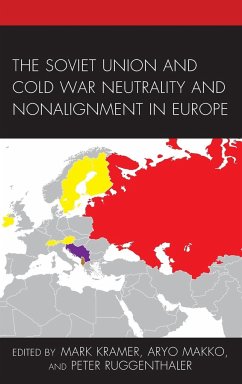The Soviet Union and Cold War Neutrality and Nonalignment in Europe
Herausgeber: Kramer, Mark; Ruggenthaler, Peter; Makko, Aryo
The Soviet Union and Cold War Neutrality and Nonalignment in Europe
Herausgeber: Kramer, Mark; Ruggenthaler, Peter; Makko, Aryo
- Gebundenes Buch
- Merkliste
- Auf die Merkliste
- Bewerten Bewerten
- Teilen
- Produkt teilen
- Produkterinnerung
- Produkterinnerung
Based on extensive archival research, the contributions in this collection examine the nuances of neutrality leading up to and during the Cold War. The contributors demonstrate the importance of the Soviet Union to the neutral states of Europe during the Cold War and vice versa.
Andere Kunden interessierten sich auch für
![The Vatican and Permanent Neutrality The Vatican and Permanent Neutrality]() The Vatican and Permanent Neutrality153,99 €
The Vatican and Permanent Neutrality153,99 €![The Vatican and Permanent Neutrality The Vatican and Permanent Neutrality]() The Vatican and Permanent Neutrality51,99 €
The Vatican and Permanent Neutrality51,99 €![Neutrality in Twentieth-Century Europe Neutrality in Twentieth-Century Europe]() Neutrality in Twentieth-Century Europe207,99 €
Neutrality in Twentieth-Century Europe207,99 €![The United States, the Soviet Union and the Geopolitical Implications of the Origins of the Cold War The United States, the Soviet Union and the Geopolitical Implications of the Origins of the Cold War]() Nicolas LewkowiczThe United States, the Soviet Union and the Geopolitical Implications of the Origins of the Cold War135,99 €
Nicolas LewkowiczThe United States, the Soviet Union and the Geopolitical Implications of the Origins of the Cold War135,99 €![Yugoslavia and the Soviet Union in the Early Cold War Yugoslavia and the Soviet Union in the Early Cold War]() Svetozar RajakYugoslavia and the Soviet Union in the Early Cold War206,99 €
Svetozar RajakYugoslavia and the Soviet Union in the Early Cold War206,99 €![Yugoslavia and the Soviet Union in the Early Cold War Yugoslavia and the Soviet Union in the Early Cold War]() Svetozar RajakYugoslavia and the Soviet Union in the Early Cold War68,99 €
Svetozar RajakYugoslavia and the Soviet Union in the Early Cold War68,99 €![Neutrality in Twentieth-Century Europe Neutrality in Twentieth-Century Europe]() Neutrality in Twentieth-Century Europe68,99 €
Neutrality in Twentieth-Century Europe68,99 €-
-
-
Based on extensive archival research, the contributions in this collection examine the nuances of neutrality leading up to and during the Cold War. The contributors demonstrate the importance of the Soviet Union to the neutral states of Europe during the Cold War and vice versa.
Hinweis: Dieser Artikel kann nur an eine deutsche Lieferadresse ausgeliefert werden.
Hinweis: Dieser Artikel kann nur an eine deutsche Lieferadresse ausgeliefert werden.
Produktdetails
- Produktdetails
- Verlag: Lexington Books
- Seitenzahl: 644
- Erscheinungstermin: 22. März 2021
- Englisch
- Abmessung: 235mm x 157mm x 42mm
- Gewicht: 1182g
- ISBN-13: 9781793631923
- ISBN-10: 1793631921
- Artikelnr.: 60414396
- Herstellerkennzeichnung
- Libri GmbH
- Europaallee 1
- 36244 Bad Hersfeld
- gpsr@libri.de
- Verlag: Lexington Books
- Seitenzahl: 644
- Erscheinungstermin: 22. März 2021
- Englisch
- Abmessung: 235mm x 157mm x 42mm
- Gewicht: 1182g
- ISBN-13: 9781793631923
- ISBN-10: 1793631921
- Artikelnr.: 60414396
- Herstellerkennzeichnung
- Libri GmbH
- Europaallee 1
- 36244 Bad Hersfeld
- gpsr@libri.de
Mark Kramer is director of Cold War studies at Harvard University and senior fellow at Harvard's Davis Center for Russian and Eurasian Studies. Aryo Makko is pro futura scientia fellow at the Swedish Collegium for Advanced Study (SCAS), professor of history at Stockholm University, and director of the Hans Blix Centre for the History of International Relations. Peter Ruggenthaler is deputy director and senior research fellow at the Ludwig Boltzmann Institute for Research on War's Consequences.
PART I. Theories and Practices of Neutrality in Cold War Europe
Chapter 1: Austria's Neutrality- Myth versus Reality
Chapter 3: Swedish Neutrality, 1949-91
Chapter 4: Swiss Cold War Neutrality: Undisputed Principle of Foreign
Policy
PART II. The Neutrals in Soviet Policy from Stalin to Gorbachev
Chapter 5: Swedish Neutrality: The View from Moscow
Chapter 6: Soviet Attitudes to Finnish Neutralism, 1947-1989
Chapter 7: A Hidden Danger for the Eastern Bloc? Neutral Austria in the
Soviet Policy from 1955 to the End of the Cold War
Chapter 8: The Soviet Union and Neutral Switzerland: Concerns and Hopes in
1989
PART III. The Soviet Union in the Policies of the European Neutrals
Chapter 9: Old Fears, New Realities: Sweden and the Soviet Union during the
Cold War
Chapter 10: From Aspiration to Consummation and Transition: Finnish
Neutrality as Strategy in the Cold War
Chapter 11: Infinite Coexistence? Austria, the Soviet Union, and Ostpolitik
after 1968
Chapter 12: "Always Hit Back Right on the Kisser?" The Soviet Union in
Swiss Foreign Policy during the Cold War
PART IV. Departures from the Eastern Bloc to Neutrality
Chapter 13: Soviet-Yugoslav Relations, 1948-1955: From Conflict to
Rapprochement
Chapter 14: The Neutrality of Hungary during the 1956 Revolution
Chapter 15: Albania: Exploiting Relevance and Irrelevance During the Cold
War
Chapter 16: How Could the Non-Aligned Save Yugoslavia? The 1989 Summit of
the Non-Aligned Countries in Belgrade and the Breakup of Yugoslavia
PART V. Western Perspectives on Neutrality and Neutral-Soviet Relations
Chapter 17: The United States and Neutrality in Scandinavia
Chapter 18: United States and Austrian Neutrality during the Cold War
Chapter 19: The United Kingdom and the European Neutrals during the Cold
War
Chapter 20: France, the European Neutrals and the USSR, 1947-1981
Chapter 21: Neutrality in the Cold War: A View from West Germany
Chapter 22: NATO and the Neutrals on the Flanks: Finland, Sweden and
Yugoslavia
Chapter 1: Austria's Neutrality- Myth versus Reality
Chapter 3: Swedish Neutrality, 1949-91
Chapter 4: Swiss Cold War Neutrality: Undisputed Principle of Foreign
Policy
PART II. The Neutrals in Soviet Policy from Stalin to Gorbachev
Chapter 5: Swedish Neutrality: The View from Moscow
Chapter 6: Soviet Attitudes to Finnish Neutralism, 1947-1989
Chapter 7: A Hidden Danger for the Eastern Bloc? Neutral Austria in the
Soviet Policy from 1955 to the End of the Cold War
Chapter 8: The Soviet Union and Neutral Switzerland: Concerns and Hopes in
1989
PART III. The Soviet Union in the Policies of the European Neutrals
Chapter 9: Old Fears, New Realities: Sweden and the Soviet Union during the
Cold War
Chapter 10: From Aspiration to Consummation and Transition: Finnish
Neutrality as Strategy in the Cold War
Chapter 11: Infinite Coexistence? Austria, the Soviet Union, and Ostpolitik
after 1968
Chapter 12: "Always Hit Back Right on the Kisser?" The Soviet Union in
Swiss Foreign Policy during the Cold War
PART IV. Departures from the Eastern Bloc to Neutrality
Chapter 13: Soviet-Yugoslav Relations, 1948-1955: From Conflict to
Rapprochement
Chapter 14: The Neutrality of Hungary during the 1956 Revolution
Chapter 15: Albania: Exploiting Relevance and Irrelevance During the Cold
War
Chapter 16: How Could the Non-Aligned Save Yugoslavia? The 1989 Summit of
the Non-Aligned Countries in Belgrade and the Breakup of Yugoslavia
PART V. Western Perspectives on Neutrality and Neutral-Soviet Relations
Chapter 17: The United States and Neutrality in Scandinavia
Chapter 18: United States and Austrian Neutrality during the Cold War
Chapter 19: The United Kingdom and the European Neutrals during the Cold
War
Chapter 20: France, the European Neutrals and the USSR, 1947-1981
Chapter 21: Neutrality in the Cold War: A View from West Germany
Chapter 22: NATO and the Neutrals on the Flanks: Finland, Sweden and
Yugoslavia
PART I. Theories and Practices of Neutrality in Cold War Europe
Chapter 1: Austria's Neutrality- Myth versus Reality
Chapter 3: Swedish Neutrality, 1949-91
Chapter 4: Swiss Cold War Neutrality: Undisputed Principle of Foreign
Policy
PART II. The Neutrals in Soviet Policy from Stalin to Gorbachev
Chapter 5: Swedish Neutrality: The View from Moscow
Chapter 6: Soviet Attitudes to Finnish Neutralism, 1947-1989
Chapter 7: A Hidden Danger for the Eastern Bloc? Neutral Austria in the
Soviet Policy from 1955 to the End of the Cold War
Chapter 8: The Soviet Union and Neutral Switzerland: Concerns and Hopes in
1989
PART III. The Soviet Union in the Policies of the European Neutrals
Chapter 9: Old Fears, New Realities: Sweden and the Soviet Union during the
Cold War
Chapter 10: From Aspiration to Consummation and Transition: Finnish
Neutrality as Strategy in the Cold War
Chapter 11: Infinite Coexistence? Austria, the Soviet Union, and Ostpolitik
after 1968
Chapter 12: "Always Hit Back Right on the Kisser?" The Soviet Union in
Swiss Foreign Policy during the Cold War
PART IV. Departures from the Eastern Bloc to Neutrality
Chapter 13: Soviet-Yugoslav Relations, 1948-1955: From Conflict to
Rapprochement
Chapter 14: The Neutrality of Hungary during the 1956 Revolution
Chapter 15: Albania: Exploiting Relevance and Irrelevance During the Cold
War
Chapter 16: How Could the Non-Aligned Save Yugoslavia? The 1989 Summit of
the Non-Aligned Countries in Belgrade and the Breakup of Yugoslavia
PART V. Western Perspectives on Neutrality and Neutral-Soviet Relations
Chapter 17: The United States and Neutrality in Scandinavia
Chapter 18: United States and Austrian Neutrality during the Cold War
Chapter 19: The United Kingdom and the European Neutrals during the Cold
War
Chapter 20: France, the European Neutrals and the USSR, 1947-1981
Chapter 21: Neutrality in the Cold War: A View from West Germany
Chapter 22: NATO and the Neutrals on the Flanks: Finland, Sweden and
Yugoslavia
Chapter 1: Austria's Neutrality- Myth versus Reality
Chapter 3: Swedish Neutrality, 1949-91
Chapter 4: Swiss Cold War Neutrality: Undisputed Principle of Foreign
Policy
PART II. The Neutrals in Soviet Policy from Stalin to Gorbachev
Chapter 5: Swedish Neutrality: The View from Moscow
Chapter 6: Soviet Attitudes to Finnish Neutralism, 1947-1989
Chapter 7: A Hidden Danger for the Eastern Bloc? Neutral Austria in the
Soviet Policy from 1955 to the End of the Cold War
Chapter 8: The Soviet Union and Neutral Switzerland: Concerns and Hopes in
1989
PART III. The Soviet Union in the Policies of the European Neutrals
Chapter 9: Old Fears, New Realities: Sweden and the Soviet Union during the
Cold War
Chapter 10: From Aspiration to Consummation and Transition: Finnish
Neutrality as Strategy in the Cold War
Chapter 11: Infinite Coexistence? Austria, the Soviet Union, and Ostpolitik
after 1968
Chapter 12: "Always Hit Back Right on the Kisser?" The Soviet Union in
Swiss Foreign Policy during the Cold War
PART IV. Departures from the Eastern Bloc to Neutrality
Chapter 13: Soviet-Yugoslav Relations, 1948-1955: From Conflict to
Rapprochement
Chapter 14: The Neutrality of Hungary during the 1956 Revolution
Chapter 15: Albania: Exploiting Relevance and Irrelevance During the Cold
War
Chapter 16: How Could the Non-Aligned Save Yugoslavia? The 1989 Summit of
the Non-Aligned Countries in Belgrade and the Breakup of Yugoslavia
PART V. Western Perspectives on Neutrality and Neutral-Soviet Relations
Chapter 17: The United States and Neutrality in Scandinavia
Chapter 18: United States and Austrian Neutrality during the Cold War
Chapter 19: The United Kingdom and the European Neutrals during the Cold
War
Chapter 20: France, the European Neutrals and the USSR, 1947-1981
Chapter 21: Neutrality in the Cold War: A View from West Germany
Chapter 22: NATO and the Neutrals on the Flanks: Finland, Sweden and
Yugoslavia








